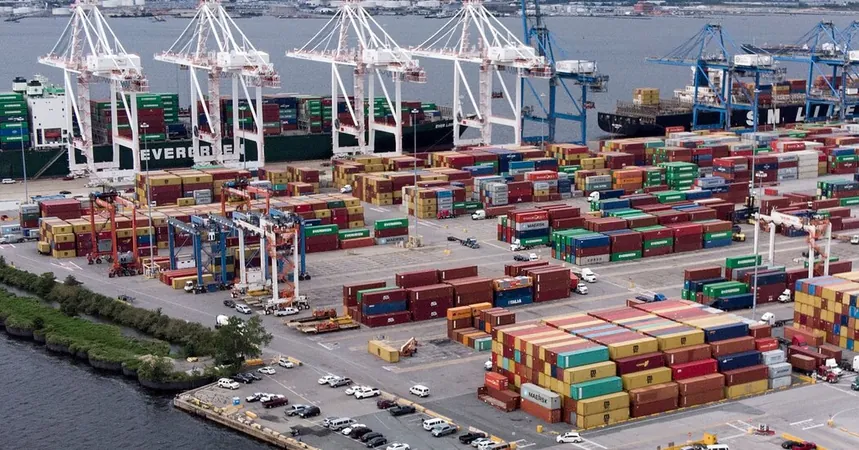
East Coast Port Strike Threat: How It Could Send the Economy into a Tailspin!
2024-09-24
Introduction
As tensions mount among dockworkers on the East and Gulf Coasts, the specter of a strike set to commence on October 1 has sent shockwaves through businesses. With the expiration of the labor contract between port terminals' operators and the International Longshoremen’s Association looming, companies are scrambling to avert a crisis.
Preparations and Redirecting Shipments
In preparation for potential disruptions, many importers have resorted to early orders, some even four months ahead of the usual timeframe for holiday goods. The urgency is palpable as they race to maneuver cargo through the ports before negotiations fall apart. Meanwhile, shipments are being redirected to West Coast ports, where a different union has already secured a new contract. Notably, the ports of Long Beach and Los Angeles report handling container volumes similar to those seen during the pandemic-era shipping surge of 2021-2022.
Economic Impact of the Strike
JPMorgan’s transportation analysts are ringing alarm bells over the economic impact a strike could have, estimating potential losses of up to $5 billion a day—an astonishing 6% of the nation’s daily gross domestic product. A shutdown of these critical ports could lead to a backlog that takes six days to clear for every day of closure.
Concerns from Importers
Chris Butler, CEO of the National Tree Company, expressed his frustration, highlighting that despite the adjustments made to import goods ahead of schedule, roughly 15% of his products could still be stranded if a strike occurs. His sentiment reflects a broader anxiety among importers: “We’re doing everything we can to mitigate it. But there’s only so much you can do when you’re at the mercy of these ports.”
Precarious Logistics in the Apparel Sector
Data reveals that more than half of the apparel, footwear, and accessories imported into the U.S. come through East Coast ports. Stephen Lamar, president of the American Apparel and Footwear Association, commented on the precariousness of logistics, noting that his sector has done its best to prepare but remains vulnerable to sudden obstacles.
Calls for Federal Intervention
The call for intervention has reached the White House, with numerous trade associations issuing an urgent plea to President Biden to broker a deal between the union and the United States Maritime Alliance, a coalition of cargo-moving companies. In turn, the union has countered that low wage increases offered by management are unacceptable.
Historical Context and Stakeholders' Worries
Should a strike occur, it would mark a first for East and Gulf Coast ports since 1977, when a similar walkout hampered retailers just before the holiday season. However, federal authorities have indicated that President Biden is not inclined to initiate a back-to-work order, which is an option under the Taft-Hartley Act.
Widespread Implications of a Strike
The implications of a strike extend far beyond just cargo delays. Major ports, including New Jersey’s vast container facilities, Virginia, Georgia, and Texas, would be brought to a standstill. The Port of Baltimore, a key hub for vehicle and heavy machinery trade, recently resumed operations after a major incident. Essential food supplies, including a significant portion of the nation’s orange juice imports, also pass through these ports, underscoring the potential for widespread disruption.
Wage Disparities and Union Responses
Inflation has left dockworkers seeking better wages, with those experienced on the East and Gulf coasts earning about $39 per hour—a figure that fails to keep pace with the 24% inflation rate over recent years. The union is pushing for $5 increases for each year of the next six-year contract, while management has offered just $2.50 annually.
Negotiation Challenges
Harold J. Daggett, the I.L.A. president, denounced the offers, pointing to the sizable profits companies reap from dockworkers’ labor. The stakes are high; the negotiations are characterized by a significant disconnect between the union’s and management’s proposals, creating a ticking clock for both sides.
Logistics and Capacity Concerns
East and Gulf Coast ports manage three-fifths of all container shipments in the U.S., and logistics experts caution that the West Coast ports simply cannot handle the overflow in the event of a strike. Though the Port of Long Beach reported record-breaking container volumes in August, the strain of increased traffic poses serious risks of delays and rising freight costs.
Conclusion and Outlook
With the clock ticking down to October 1, the balance hangs precariously. Should a strike occur, expect not just delays and shortages but a potential economic shockwave that could haunt the holiday shopping season. As companies grapple with logistics and rising costs, the very fabric of the nation’s supply chain is at risk of unraveling. Will negotiations be salvaged before the clock strikes? Time will tell, but the signs are grim for businesses and consumers alike.



 Brasil (PT)
Brasil (PT)
 Canada (EN)
Canada (EN)
 Chile (ES)
Chile (ES)
 España (ES)
España (ES)
 France (FR)
France (FR)
 Hong Kong (EN)
Hong Kong (EN)
 Italia (IT)
Italia (IT)
 日本 (JA)
日本 (JA)
 Magyarország (HU)
Magyarország (HU)
 Norge (NO)
Norge (NO)
 Polska (PL)
Polska (PL)
 Schweiz (DE)
Schweiz (DE)
 Singapore (EN)
Singapore (EN)
 Sverige (SV)
Sverige (SV)
 Suomi (FI)
Suomi (FI)
 Türkiye (TR)
Türkiye (TR)